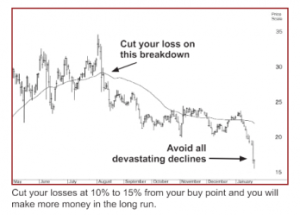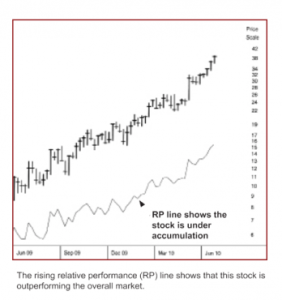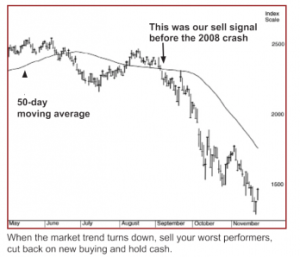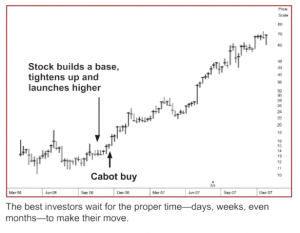The #1 Rule for Growth Stock Investors
Most investors have rules and tools when it comes to investing, things that they believe put the odds more in their favor and, over time, result in bigger profits. We’ve been around more than 40 years and have quite a few rules and tools of our
own. But the #1 rule that has kept us thriving for four decades is simple: We cut every loss short.
That one rule—cutting losses short—is the best way to make money in the long run. “But Mike,” you ask, “how can taking losses help me make more and bigger profits?” It’s a bit counterintuitive, but the reason it’s true is because, if you never lose big, it’s almost impossible for you to get too far behind the curve. Said another way: If you don’t lose big, you dramatically increase the value of all your winning trades. One 50% winner (a good trade), for instance, makes up for five 10% losses (bad trades).
It’s like having a great defense as a football team; if the opponent can never get in the end zone, all you need is a couple of good drives each game to get a victory. Thus, be sure to cut each and every loss, usually in the 8% to 12% range, but certainly no more than 20% from your buy point. Doing so will automatically put you ahead of 90% of investors!
Focus on the Best Stocks
Most investors earn nothing-to-write-home-about returns for one simple reason: They invest in nothing-to-write- home-about stocks! You know what I’m talking about— companies that have sub-par growth, lots of competition, or simply a promise of something better down the road. Hey, if investing in those companies worked, I’d be all for it. But that just isn’t reality.
The fact is that the stocks that do best—what we like to call leading stocks—almost always have certain characteristics in common. They sport fast sales and earnings growth, along with the promise of better growth in the quarters to come. They offer a unique, possibly revolutionary product or service. They have big profit margins, a sign that management is capable and competition is at bay.
And, importantly, they have a stock that acts well—one that is generally outperforming the market. That tells you that big investors (mutual funds, pension funds, etc.) are picking up shares on each pullback, anticipating great things for the company as the weeks and months pass. You should work hard to focus solely on both successful companies and successful stocks—it’s the combination of the two that allows you to consistently find stocks capable of making big moves.
Market Timing Matters
Gone are the days of the 1990s, when every two- or three- month dip was buyable and even so-so stocks ran up with everything else. Today, after a decade with two punishing bear
markets that ravaged many investors’ portfolios and retirements, you know better—market timing matters.
At Cabot, we have a successful history of timing the market’s major moves. Our system is simple: We analyze the intermediate-term and longer-term trends of the market. When the trends turn down, we turn defensive by selling our worst performers, cutting back on any new buying and holding cash. And when the trend turns back up, we start buying again. Like we said, simple.
The big benefit of such an approach is that you are guaranteed never to miss a major market upmove, and you’re also guaranteed never to remain heavily invested during a prolonged downmove. (We were 90% in cash by the time the September 2008 Lehman/AIG meltdown occurred.) On the flip side, there will be the occasional whipsaw—a signal that is quickly reversed—but because we only get a handful of signals each year (if that many), it’s not a big drawback.
Besides, any whipsaw is a tiny price to pay for assurance that you’re going to be in every bull market, while sitting out the vast majority of any bear markets that come along. Bottom line: Pay attention to and respect the market’s trends.
Patience Precedes Profits
Most beginners in the stock market think the more they trade, the more money they’ll make … when just the opposite is true. It turns out that the best investors are extraordinarily patient in two different ways.
The first is in waiting for the right opportunity to come along, both in terms of the right stock (with all the characteristics we look for), a low-risk buying set-up (possibly after the stock has pulled back for a couple of weeks and is trading quietly) and the proper market environment. In other words, the best investors wait for days, weeks, even months for the proper time to make their move.
And then, once they make their commitment and are off to a good start, they practice patience with their winners… giving them chances to turn into big winners that really make a huge difference in their portfolio. Thus, most of investing is identifying top stocks, waiting for the right entry point, and then sitting with winners. Plenty of patience needed!
Plan your Trade, and Trade your Plan
In life, emotions are a great thing. In the market, not so much. It’s a simple fact that if you invest based on how you feel, you’re going to lose money … probably a lot of money.
When you’re most excited, it’s likely to be near a short-term top. And then, when you feel like stocks are heading through the floor, they’ll begin to rally.
Thus, you need a plan—maybe not a daily plan (unless you fancy yourself a day trader), but a set of rules and tools, as well as specific buy and sell points for selected stocks. That way, when the news is flying fast and furious, and your stocks are heading up, down and all around, you’ll have your trusty plan to follow.
This doesn’t mean you have to spend an hour every night looking at hundreds of stocks (that’s our job!). But you should have a plan in place to deal with contingencies, whether it’s trailing stops, potential buy points or market timing levels.
Getting to Know Charts
Many investors believe that stock charts are not only confusing, but worthless. Others believe charts are able to forecast a stock’s or a market’s future movements. We fall somewhere in between; they are a vital piece of the investing puzzle … but only if you know how to use them.
The big benefit of charts is that they give you a view of the stock’s supply/demand situation. No matter how good you or anyone thinks a company is, the stock won’t go up unless there’s enough demand for the shares. The company, in other words, is not the stock!
Back to charts, half the battle is in making sure the stock you’re interested in is in an overall uptrend; as we wrote in the above section “Focus on the Best,” chasing downtrending stocks is not the best way to make money. In fact, it’s usually a good way to lose money. So, getting in the habit of checking a stock’s chart to make sure it’s trending generally higher is a good idea.
But there’s much more to charts than that. The more you study them, the more you’ll discover that they can help you identify abnormal action—either abnormally good (such as a powerful breakout of a tight trading range on huge volume), or abnormally bad (such as big-volume weakness through a key support level, like the 50-day moving average).
Using charts is more art than science, and as we wrote above, charts are a key part to the investment puzzle (but not the only piece). The more you work on chart-reading skills, the better an investor you’ll be. We’re happy to help you along the way.
Let (Most of) Your Winners Run
Psychological studies have shown that investors’ minds don’t seek to maximize profits … they seek to maximize the probability of making a profit. That means that when the average investor has a profit of a few points, he tends to book it (locking in the gain), instead of giving the stock a chance to develop into a bigger winner (but taking the risk that the small profit could disappear).
In our experience, that’s the wrong thing to do. Sure, seeing a profit of 5% or 10% go up in smoke is never fun, but the fact is, if you’re going to make big money in the market, you’re going to need to develop a few big winners. And the only way to do that is to give some of your initially profitable trades a chance to keep running and running.
Now, you’ll notice in the title of this section we mentioned letting most of your winners run. If you’re running a fairly concentrated portfolio, it’s ok to take a few chips off the table on the way up from time to time. If you get a decent profit, you might sell one-quarter or one-third of your shares, putting some profit in the bank while still attempting to hit a home run with your remaining shares. Doing that is a logical compromise if you still want to book profits when you have them.
Hey! What’s the Big Idea?
The big winners of bull markets aren’t just random companies. Sure, there might be a few low-priced darlings that race up the charts on merger speculation or something like that. But the vast majority of big winners have big sales and earnings growth, and the reason they do is because the companies have big ideas.
By that, we mean that the company offers a potentially revolutionary product or service that is serving a huge mass market. In other words, there’s little ceiling on a firm’s potential growth—the product is changing the way we live or work, so if management executes, the sky’s the limit.
Of course, in a bull market, you’ll find lots of good stories; just remember that while most big winners have big stories, not every big story leads to a big winning stock. In other words, you shouldn’t be buying solely because the story is good. Pipe dreams aren’t allowed! You should combine a good story with good numbers—most big winners show great sales and earnings growth before they lift off—to raise your odds of success.
Concentrate in Your Best Ideas
Most everyone on Wall Street advises you to diversify, but the truth is that when investing in growth stocks, it’s best to do the opposite—to concentrate in relatively few positions, and then to watch them carefully.
So what is “relatively few positions”? We’ve always thought that, when fully invested, owning between five stocks (on the most aggressive end) up to 12 stocks (less aggressive) is the right mix. Maybe if you have lots of experience and time, you could go up to 15 names. But, at least for growth investing, you want to avoid having 20, 25 or 30 stocks. The reasons for that are many.
First and foremost, by its nature, growth stock investing is really about finding a handful of big winners—fewer holdings means you’ll get more bang for your buck from your winners. A second benefit comes from market timing; when the market turns down, you want to raise cash. With just a handful of stocks, selling two or three make you defensive in quick fashion. But if you own 30 stocks, selling two or three (or even four or five) won’t do much to shield you from a big drop.
Of course, having fewer stocks means your portfolio will be more volatile … not always the most pleasant thing. But if you can handle it, having fewer eggs in your basket will allow you to better focus on your best ideas, follow them more closely, and earn better returns in your portfolio.
Never Stop Learning
OK, so the last of our 10 ways to make more money in growth stocks isn’t any secret portfolio management or stock picking trick. But it’s just as important as anything we’ve written about. Most investors put together a plan and start buying and selling stocks … but when they make a bad trade (as we all do), they don’t revisit it or learn anything from it.
That’s a big mistake—in fact, just by eliminating one major fault from your trading every year (say, buying stocks when they’re extended in price, or buying low-quality stocks, or ignoring market timing and buying during downtrends, etc.), your returns should skyrocket over time. Also important is learning what you do best, and making an effort to emphasize that in your trading.
But the only way to improve is to set aside some time every few months, examine some of your best and worst trades during that time, and learn how you can do things better. This is the real difference between great investors and average investors—the great ones are always learning and improving their skills.




